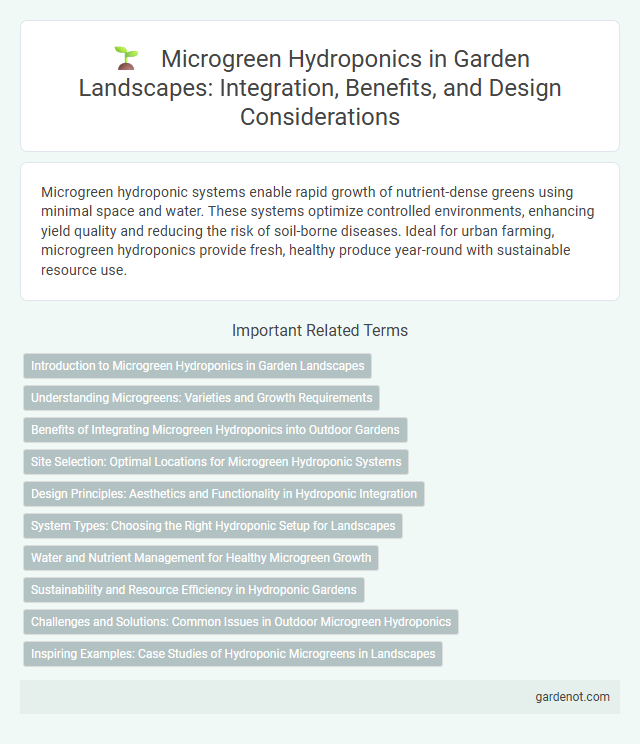Microgreen hydroponic systems enable rapid growth of nutrient-dense greens using minimal space and water. These systems optimize controlled environments, enhancing yield quality and reducing the risk of soil-borne diseases. Ideal for urban farming, microgreen hydroponics provide fresh, healthy produce year-round with sustainable resource use.
Introduction to Microgreen Hydroponics in Garden Landscapes
Microgreen hydroponics integrates soil-free cultivation techniques within garden landscapes, enabling rapid growth of nutrient-dense young plants in controlled environments. This method optimizes water and nutrient use efficiency while providing fresh, flavorful microgreens year-round. Incorporating microgreen hydroponics into garden landscapes enhances aesthetic appeal and promotes sustainable urban agriculture.
Understanding Microgreens: Varieties and Growth Requirements
Microgreen hydroponic systems support a wide range of varieties such as kale, arugula, basil, and radish, each requiring specific light, temperature, and nutrient conditions for optimal growth. These young plants thrive in controlled environments with consistent moisture levels, adequate airflow, and balanced nutrient solutions to ensure rapid germination and nutrient density. Understanding the unique growth requirements of different microgreens enables efficient hydroponic cultivation, resulting in higher yields and enhanced flavor profiles.
Benefits of Integrating Microgreen Hydroponics into Outdoor Gardens
Integrating microgreen hydroponics into outdoor gardens enhances plant growth by providing nutrient-rich, soil-free conditions that increase yield and reduce water consumption by up to 90%. This sustainable method accelerates harvest cycles, allowing gardeners to produce fresh, nutrient-dense microgreens year-round with minimal pest issues. Improved space utilization and reduced dependency on traditional soil-based techniques make hydroponic microgreens an efficient solution for urban and small-scale agricultural landscapes.
Site Selection: Optimal Locations for Microgreen Hydroponic Systems
Selecting an optimal site for microgreen hydroponic systems requires consistent access to natural or artificial light, stable temperature ranges between 65-75degF, and proper humidity levels around 50-70%. Proximity to water sources and ease of maintenance accessibility improve operational efficiency and reduce resource waste. Urban rooftops, controlled greenhouses, and indoor vertical farming spaces are prime locations that maximize space utilization and environmental control for high-yield microgreen production.
Design Principles: Aesthetics and Functionality in Hydroponic Integration
Microgreen hydroponic design principles emphasize both aesthetics and functionality by integrating compact, visually appealing layouts that maximize space efficiency and plant health. Optimal lighting, nutrient flow, and air circulation are crucial to support rapid growth cycles while maintaining a clean, modern appearance that complements indoor environments. Strategic placement of trays and modular systems enhances accessibility for maintenance and harvest, ensuring sustainable productivity within urban hydroponic landscapes.
System Types: Choosing the Right Hydroponic Setup for Landscapes
Microgreen hydroponic systems for landscapes primarily include nutrient film technique (NFT), deep water culture (DWC), and aeroponics, each offering distinct advantages in growth rate and space efficiency. NFT systems deliver a continuous flow of nutrient solution over roots, ideal for vertical installations and maximizing planting density. DWC provides a highly oxygenated root environment through submerged roots suspended in nutrient-rich water, while aeroponics suspends roots in air with nutrient misting, optimizing oxygen intake for rapid microgreen development in compact landscape designs.
Water and Nutrient Management for Healthy Microgreen Growth
Effective water and nutrient management in microgreen hydroponics is crucial for optimizing growth and ensuring nutrient density. Precise control of pH, electrical conductivity (EC), and dissolved oxygen levels promotes efficient nutrient uptake and prevents root diseases. Implementing automated drip irrigation systems and regularly monitoring nutrient solutions enhances water use efficiency and supports robust, healthy microgreen development.
Sustainability and Resource Efficiency in Hydroponic Gardens
Microgreen hydroponic systems optimize sustainability by significantly reducing water usage compared to traditional soil cultivation, often using up to 90% less water. These systems leverage nutrient-rich water recirculation, minimizing waste and enhancing resource efficiency in urban agriculture. Rapid growth cycles of microgreens also contribute to higher yield per square foot, maximizing space utilization and reducing the carbon footprint of hydroponic gardens.
Challenges and Solutions: Common Issues in Outdoor Microgreen Hydroponics
Outdoor microgreen hydroponics often faces challenges such as unpredictable weather conditions, pest infestations, and nutrient imbalances that can hinder plant growth and yield. Implementing climate control systems, integrated pest management, and precise nutrient monitoring solutions helps mitigate these issues effectively. Utilizing protective netting and automated nutrient delivery systems enhances crop resilience and ensures consistent microgreen quality in outdoor hydroponic setups.
Inspiring Examples: Case Studies of Hydroponic Microgreens in Landscapes
Hydroponic microgreens have transformed landscape design by integrating nutrient-rich, soil-free cultivation directly into urban and residential settings, enhancing both aesthetic and functional value. Case studies such as the Brooklyn Grange rooftop farm demonstrate how microgreen hydroponic systems optimize space and yield, delivering fresh, sustainable produce within cityscapes. These examples highlight innovative layering techniques and automated nutrient delivery that maximize growth rates while promoting eco-friendly landscaping practices.
Microgreen hydroponic Infographic

 gardenot.com
gardenot.com